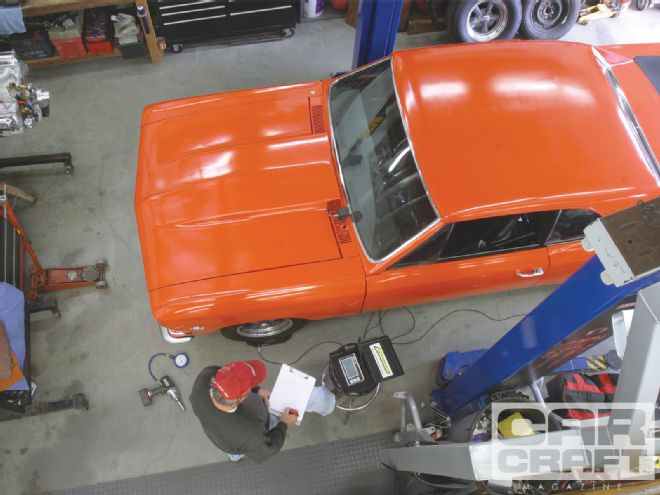
The trickle-down theory states that if enough racers demand a particular part or tool, manufacturers will make a raft of them and the price will eventually become reasonable enough that a street car guy might consider spending a few dollars to go faster. Electronic weight scales are a classic illustration of this point. Three decades ago, only big-dollar Indy or NASCAR cars used expensive electronic scales to measure corner weights. We envied the teams that could afford such a sophisticated way of evaluating weight distribution in the car. While that method is considered essential for a road course or circle track car, the laws of physics don't change just because the car is only pointed straight. We thought it would be fun to look at how to measure weight to give us an idea of how that can affect performance and traction.
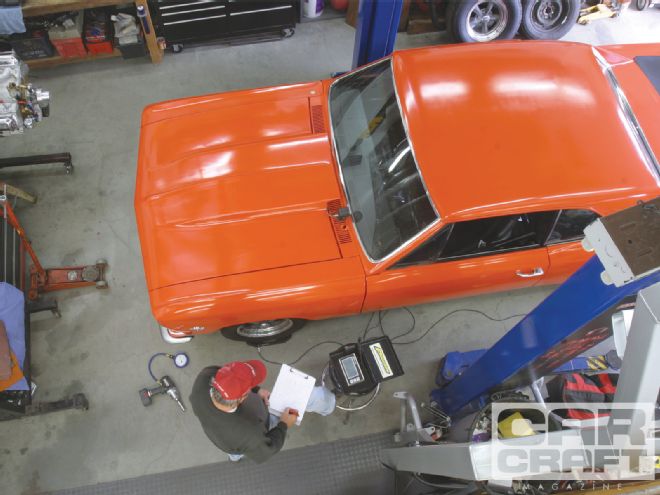 Scaling a car is easy with the right tools and may unlock secrets to handling and straight line acceleration that will make your car quicker and more stable at high speeds.
Scaling a car is easy with the right tools and may unlock secrets to handling and straight line acceleration that will make your car quicker and more stable at high speeds.
It's actually very easy to spend a lot of money on weight-measuring equipment, especially with the trick wireless systems now on the market. But the popularity of electronic devices has certainly contributed to a gradual softening in the price for basic hardwired scales. We discovered a set of scales from Proform that seemed attractive at less than $750. These budget scales produce the same basic information for much less than the high-dollar systems. And that makes it a Car Craft kind of story.
Playing the Scales
All electronic scales operate on the same principle. Place a sensor under each tire and it will indicate the amount of weight on each corner of the car. In the case of these Proform scales, each has a 1,250-pound capacity, giving the entire system a 5,000-pound limit. Each scale is made of lightweight aluminum measuring 14.5 inches long, 9.5 inches wide, and 2.5 inches tall. Four 20-foot-long cables connect the scales to the central display powered by four simple AA batteries, making the system completely portable. The digital display for this particular unit is simple, giving you a weight for each tire, a corner percentage, and a vehicle total.
The more expensive scales will calculate the left- and right-side percentages as well as cross weights automatically for you and display them on the screen. The Proform scale does deliver percentages at each corner, so all you have to do is simply add the numbers for left or right. As for determining the cross weights, the calculation is as simple as adding LF and RR, and RF and LR together for percentages or weight. These are simple steps you can do with a calculator and save a few hundred dollars in the process. To illustrate, let's keep the numbers really simple with the following quick example:
CALCULATING PERCENTAGES LF RF 900 850 Total: 3,150 28.5% 27.0% Front: 55.5% Rear: 44.5% LR RR Left side: 50.75% 700 700 Right side: 49.25% 22.25% 22.25% Cross weight: LF/RR: 1,600 pounds 50.75% RF/LR: 1,550 pounds 49.25%
As you can see, the total weight is 3,150 pounds. We can also see that the front is pretty heavy at 55.5 percent, so some weight could move to the back to help traction. In addition, the left side is heavier than the right by 1.5 percent, which isn't unusual given the car was weighed with the driver. If we were building a road race car, we would want to equalize the weight on the two front tires to make the car easier to turn in both directions.
Another popular evaluation is cross weight, which is the combined weight of opposite corners LF and RR compared with RF and LR. In our example, the cross weights reveal a difference of 1.5 percent. Ideally, we'd prefer equal cross weights. The difference is the extra 50 pounds sitting on the left front. If this were a car that we autocrossed or road raced, the additional weight on the left front would tend to make the car more efficient in lefthand turns (where the weight transfers to the right front) as opposed to a righthand turns where the weight moves to the left front that's already slightly heavy. The 50 pounds in our example is not excessive. A cross weight difference approaching 100 pounds or more would be noticeable and worth correcting.
The Checklist
As soon as you get the scale, the first thing everyone wants to do is roll a car up on it and see what it weighs. While that's understandable, it's also a bit premature. To use these scales to accurately measure your car, you need to make sure the scales are level and the car is tested the same way every time. To this end, we've made up a short checklist you should consult each time before the first weight is taken. Many of these points will not change from test to test, but they're included here so you gain an understanding of how they affect weight distribution in the car. Of these points, tire pressure is subject to the most variation. It's also critical that all nonessential items be removed from the interior and trunk. Note that the sway bar should be disconnected. It is possible to alter weight distribution with the sway bar, which is why it's best to disconnect one side of the bar. Then make sure that reconnecting the bar does not significantly change the weight distribution.
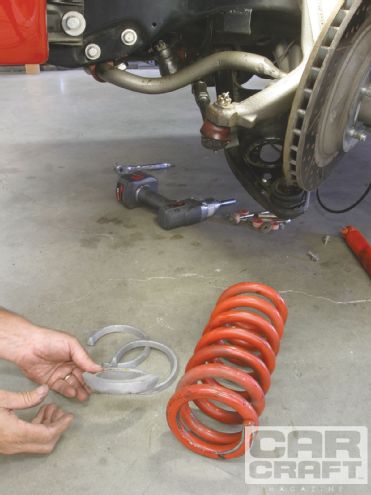 We decided to scale our '65 El Camino and discovered the ride height on the left front was 3/8 inch lower than the right. This required placing a shim under the short coil spring to level the ride height. Remember that the ratio is approximately 2:1, meaning a 1/2-inch spacer under the spring will increase the ride height 1 inch.
We decided to scale our '65 El Camino and discovered the ride height on the left front was 3/8 inch lower than the right. This required placing a shim under the short coil spring to level the ride height. Remember that the ratio is approximately 2:1, meaning a 1/2-inch spacer under the spring will increase the ride height 1 inch.
Accuracy Test
The idea behind using any precision instrument is that the test procedure is consistent with every use. The point is to produce the most accurate and repeatable data. Before we could even begin weighing cars, we had to determine if our shop floor was level-and if not, what we had to do to make the scales level. My engineering accomplice, Don Young, suggested we use a laser to determine height, so we borrowed a Craftsman Laser Trac. Unfortunately, one bubble level had leaked and we discovered the other wasn't accurate, so we used a separate digital level to square the laser. Once that was accomplished, we found the slope of the shop floor was roughly 1/2 inch spanning 115 inches (the Chevelle's wheelbase), which required raising the rear scales. We also leveled the scales side to side to ensure all four were the same height.
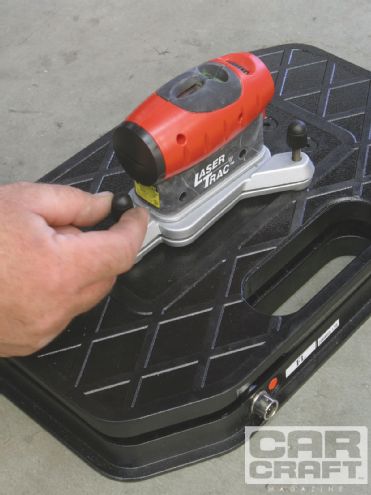 We used a Craftsman Laser Trac to adjust the height of all four scales to ensure our results would be consistent. We discovered we needed a 1/2-inch shim under the two rear scales to level everything both fore/aft and left to right.
We used a Craftsman Laser Trac to adjust the height of all four scales to ensure our results would be consistent. We discovered we needed a 1/2-inch shim under the two rear scales to level everything both fore/aft and left to right.
Once the scales were leveled, we decided to build four ramps so we could drive the car on the scales rather than jack the car and lower it onto the scales. The contention is that the front suspension will bind slightly if lowered onto the scales, which will affect the accuracy and repeatability of our tests. We decided to put all this to the test using the scales in all three situations. Our first test was to lower the Orange Peel Chevelle down on nonlevel scales. Next, we repeated this same test with the scales leveled and jounced the car twice on each corner to settle the springs and shocks. Then we raised the car, removed the scales, backed the car out, and drove the Chevelle up on the scales using our wooden ramps without jouncing the suspension and with the driver in the car. The first thing we noticed was that the total weight was not the same among the three tests, with the total changing by as much as 6 pounds and one corner that changed by as much as 13 pounds. After several more attempts lowering the car and using the jounce method, we found that 3,472 pounds became the most consistent figure. After leveling the scales and jouncing the car, the weight moved around a little to the rear. The ramp test moved the weight around a bit again, but the change was less than 1 percent-and the ramps frankly were a hassle. So for us, it was easier to raise and lower the car using our hoist or a floor jack, and we produced more consistent results this way compared with using the ramps. So we learned that we have to use the scales in the same spot on the shop floor and test the same way each time. A difference of a couple of pounds will not be critical in terms of vehicle performance, but it helps to be as accurate as possible. Another common solution is to build working stands the same height as the scales, which would allow us to lower the car on the stands, settle the suspension, and then roll the car onto the scales. Whichever procedure you decide to use, make sure to scale the car the same way each time.
Mustang Adventures
You can expect to become increasingly popular once your buddies discover you own a set of scales. We invited Greg Smith to bring over his 10-second nitrous'd, leaf spring '67 Mustang. The car has always launched straight, so we weren't anticipating major rear weight differences. With driver weight and half a tank of fuel, we discovered less weight in the right rear (the opposite of what we found without the driver in the car). The difference in left-to-right rear weight was 35 pounds, which is slightly more than 1 percent. Calvert Racing prefers minimizing preload, as this creates rear suspension bind, so we did not modify the weight distribution. Plus, the cross weight was within 4 pounds, which is a big reason why the car tracks straight.
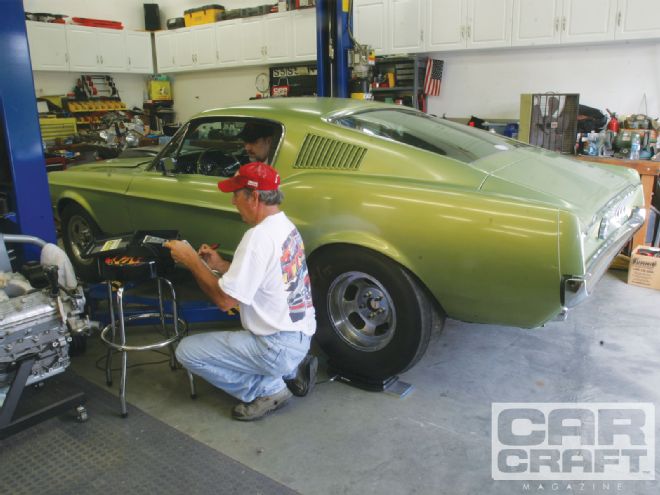 We also scaled this Mustang just to look at a leaf spring car. Adding preload to the right rear CalTracs bar generally increases load to the right rear and the left front. This is most often used to help the car launch straight.
We also scaled this Mustang just to look at a leaf spring car. Adding preload to the right rear CalTracs bar generally increases load to the right rear and the left front. This is most often used to help the car launch straight.
MUSTANG WEIGHT LF RF 907 876 (27.2%) (26.2%) LR RR 796 761 (23.8%) (22.8%) Total: 3,340 with driver (3,130 without) Front/Rear: 53.4%/46.6% Left side: 51% Right side: 49%
Scaling a Street/Strip Car
Once we developed a system to generate repeatable numbers, we decided to test our Orange Peel Chevelle. We unhooked the front sway bar and installed our 26-inch-tall M/T ET Street dragstrip tires with 18 psi of pressure. We filled the gas tank and rolled the car on the scales. The Orange Peel has grown portly since our story on reducing weight ("Trim The Fat" Nov. '09), including the swap of the iron-block Lester Scruggs 404ci motor, a complete Weldon fuel delivery system, a 3-inch Flowmaster exhaust, a front sway bar, and a copper/brass radiator to combat a nagging electrolysis issue. Here's how it shakes out with the driver in the car:
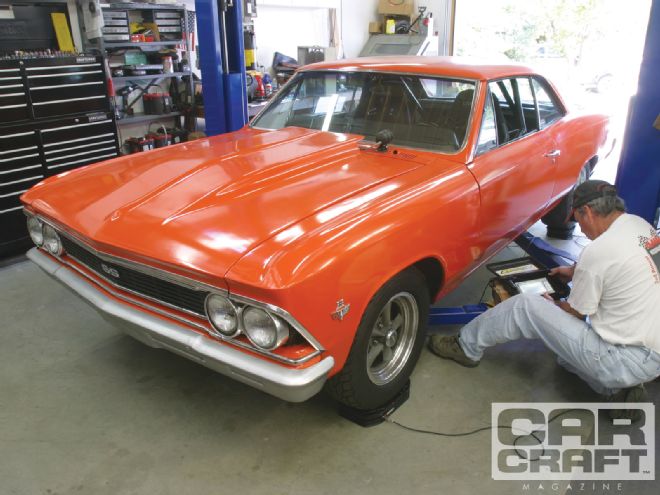 It's always best to test the car both with driver weight in and out to get a sense of how that weight change affects the car.
It's always best to test the car both with driver weight in and out to get a sense of how that weight change affects the car.
TEST ONE LF RF Total: 3,472 pounds 1,024 894 Front: 1,918 pounds—55.2% (29.5%) (25.7%) Rear: 1,554 pounds—44.8% Left side: 1,795 pounds—51.7% LR RR Right side: 1,677 pounds—48.3% 771 783 (22.2%) (22.6%)
We were a little surprised at how much weight the Chevelle had gained at 3,472 pounds. Do they make lap bands for Chevelles? Driver weight contributes 193 pounds to the car, making it 3,279 without driver. If we put staffer McGann in the car, we can trim 63 pounds right there! We elected to retain the battery in its right-front location, but for fun we moved the 41-pound Optima RedTop to the right rear to evaluate the change:
TEST TWO LF RF Total: 3,471 pounds 988 868 Front: 1,856 pounds—53.5% (-62 pounds) (28.5%) (25.0%) Rear: 1,615 pounds—46.5% (+ 61 pounds - 1.7%) Left side: 1,790 pounds—(-5 pounds) LR RR Right side: 1,681 pounds—(+4 pounds) 802 813 (23.1%) (23.4%)
As you can see, we lost a pound somewhere, but moving that heavy battery more than 11 feet to the back in the car had a serious effect on weight distribution of 1.75 percent or 61 pounds, which is nearly 50 percent more than the weight of the battery because we moved it farther behind the rear axle than it was ahead of the front axle. The right rear gained 30 pounds, with the left rear adding the other 31. Frankly, we expected more of a change on the right rear.
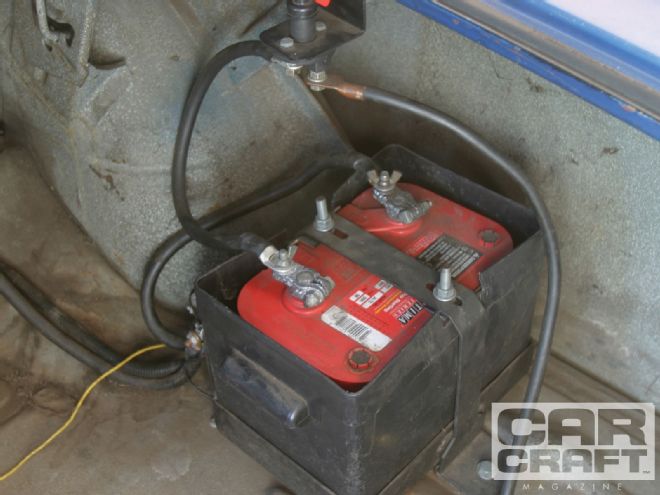 Moving the battery to the trunk is the classic way to redistribute weight to the rear. Consider that to run at your local dragstrip, safety rules require a remote battery shutoff switch located at the rear of the car.
Moving the battery to the trunk is the classic way to redistribute weight to the rear. Consider that to run at your local dragstrip, safety rules require a remote battery shutoff switch located at the rear of the car.
We also thought it would be interesting to test how ballast altered the weight distribution. First we added 45 pounds directly over the center of the rear axle. We then moved that weight 34 inches behind the rear axle and 24 inches to the left of center. Then we placed the weight in the opposite far right-rear corner and recorded the following results:
TEST THREE Weight on center Weight in Left Rear Weight in Right Rear LF RF LF RF LF RF 990 866 988 851 971 870 (28.2%) (24.6%) (28.1%) (24.2%) (27.6%) (24.7%) LR RR LR RR LR RR 823 837 846 831 818 857 (23.4%) (23.8%) (24.1%) (23.6%) (23.3%) (24.4%) Total: 3,516 Front/Rear: 52.8%/47.2% Front/Rear: 52.3%/47.7% Front/Rear: 52.3%/47.7% Left side: 51.6% Left side: 52.2% Left side: 50.9% Right side: 48.4% Right side: 47.8% Right side: 49.1%
This was an interesting test because 45 pounds increased the total rear weight distribution percentage from 46.5 percent with the battery in the rear to just over 47 percent. And when the weight was moved to the right side alongside the battery, the right-rear weight jumped to 24.4 percent, which is 44 pounds of additional downforce over the right-rear tire. If we calculate cross weight in this final configuration, the LF/RR comes in at 52 percent, while the RF/LR direction is 48 percent. Increasing the load on the right rear may not be worth carrying the extra weight unless the car has traction problems. Remember that under acceleration, the rear axle attempts to lift the right-rear tire off the pavement. Additional weight on this corner (in addition to the battery) may improve acceleration despite the weight penalty. In addition, there may be handling issues here because the cross weight difference is 140 pounds, which is significant.
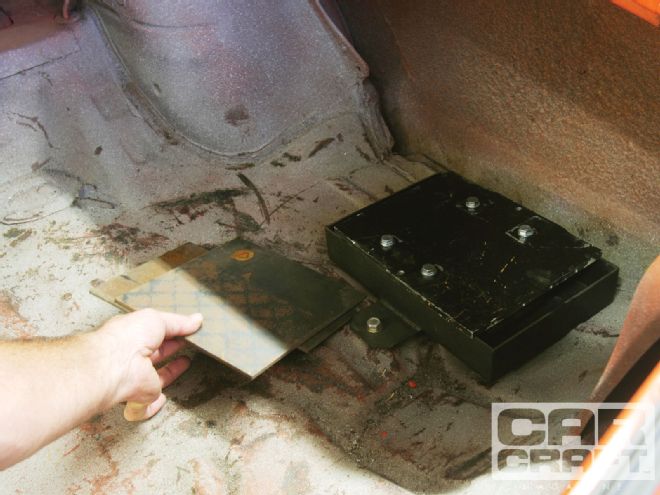 Moving weight behind the rear axle multiplies the effect. We spoke to an NMCA racer who mentioned that just moving ballast several inches behind the rear axle was sufficient to radically increase the car's tendency to wheelstand. He was able to tune the launch with minor weight repositioning.
Moving weight behind the rear axle multiplies the effect. We spoke to an NMCA racer who mentioned that just moving ballast several inches behind the rear axle was sufficient to radically increase the car's tendency to wheelstand. He was able to tune the launch with minor weight repositioning.
PARTS LIST DESCRIPTION PN SOURCE PRICE Craftsman Laser Trac LM013N Sears $34.99 Speedway scale levelers 91082650 Speedway Motors 24.99 Proform digital scales 67650 Summit Racing 729.95 Proform wireless scales 67651 Summit Racing 1,097.99